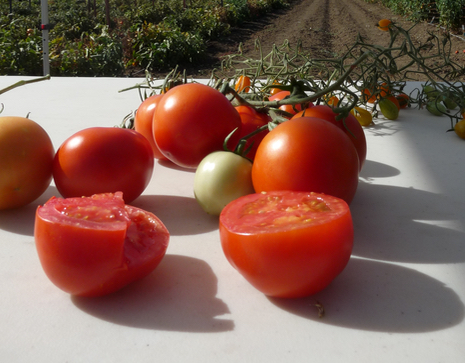
Grafting Can Yield Bigger, Better Tomatoes
By Jessica Theisman, Associate Editor
Brenna Aegerter is a San Joaquin County Cooperative Extension Farm Advisor. She specializes in vegetable crops, and she’s working on tomato plant grafting for market tomatoes. “Right, they would be doing it at the greenhouse. They’d start off the plants like normal, except they’re planting both the rootstock and the regular fruiting variety, so you’re planting two seeds. Then, these little seedlings are cut in half and put back together with the root stock on the bottom” Aegerter said.
The tomatoes are then placed in a dark, humid chamber, which allows them to heal for about one week. Following this step, the plants are then moved back into the greenhouse. This process speeds up the growth cycle on these plants by about two weeks. When the tomatoes are ready to ship, they look the same as any tomato plant except; these have a plastic clip that helps support the graft union. “It’s really soft, like a biodegradable silicon,” Aegerter said.
There are a few reasons why this process is necessary. “We want to increase the vigor of the plants, and we want more fruit, more vine, and bigger fruit. This is for fresh market tomatoes,” Aegerter explained.
It is not necessary on processing tomatoes, as the grower wants total tonnage. “We’re looking for some resistance to some of these diseases that we have. The idea being that maybe we can reduce,” Adgerter said.
One way to avoid the soil borne diseases is to plant tomatoes with the grafting union above the soil. These tomatoes however, have a tall transplant and most of the stem is buried. There’s no way in current production practices to plant with the union above ground. “But even with the deep roots, the rootstock is vigorous,” Aegerter said.
This rootstock must be bred. Sometimes they are a wild species, but for the most part, they are hybrids of wild and cultivated tomatoes. They contain some characteristics of a wild tomato but have a tomato rootstock breeder. The breeder, Monsanto/Seminis, is working worldwide for different markets. “[Their] job is breeding rootstocks,” Aegerter said.
This practice is an emerging standard that is becoming more common in other parts of the country. This takes place in the Southeast such as North Carolina. They are growing stake tomatoes, which is a very different production system. They pick multiple times while growers in California pick once.
The greenhouses aren’t set up with automated grafting. All of the grafting is done by hand. “To bring that cost down to a price that we’d like to see, they’re going to have to be more automated. But how can they justify the decision to invest in very expensive automated grafting equipment, if they don’t know if the market is there?” she said.








